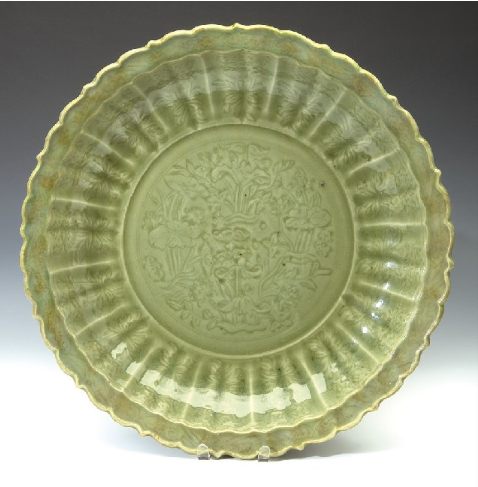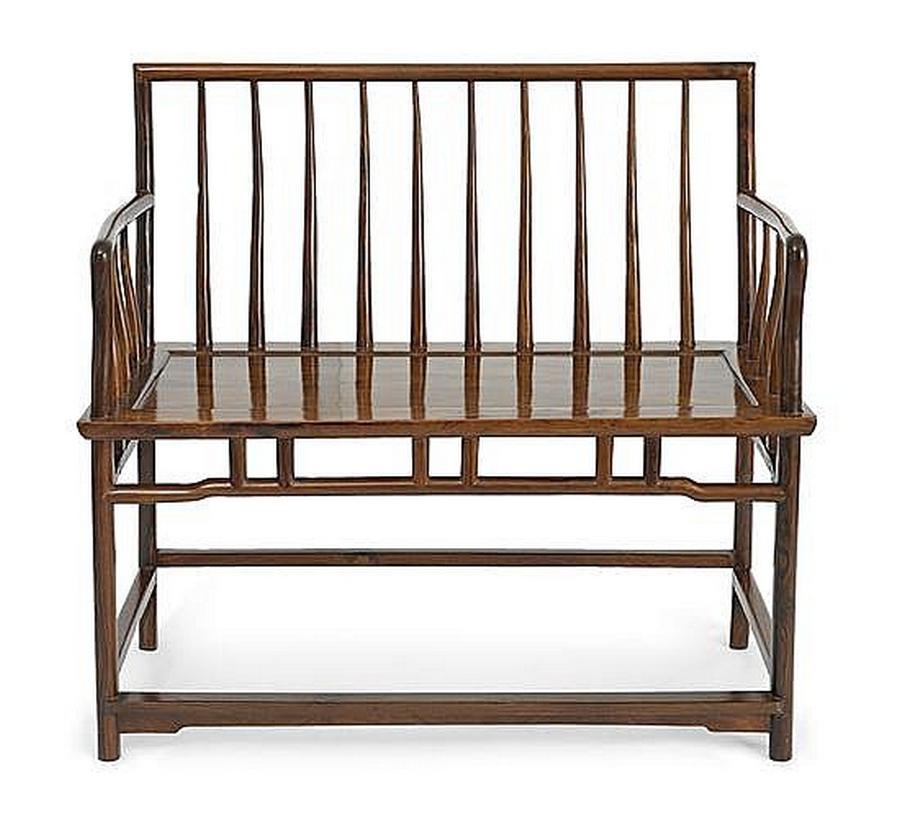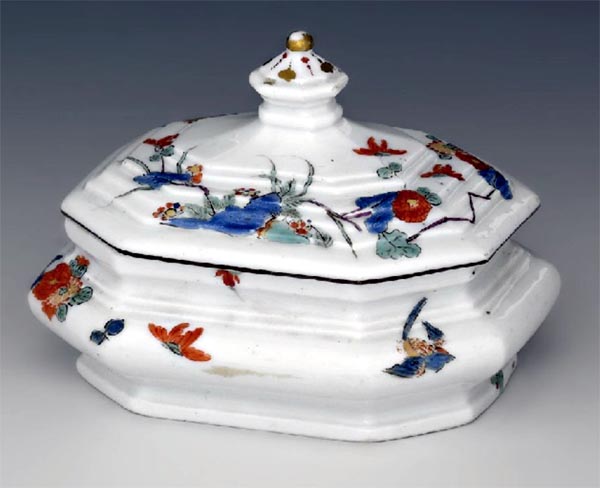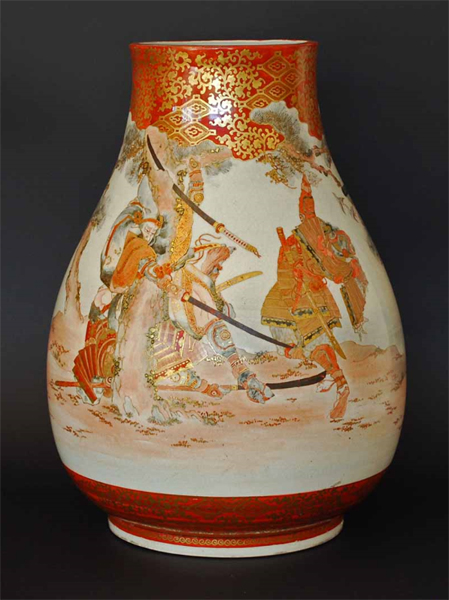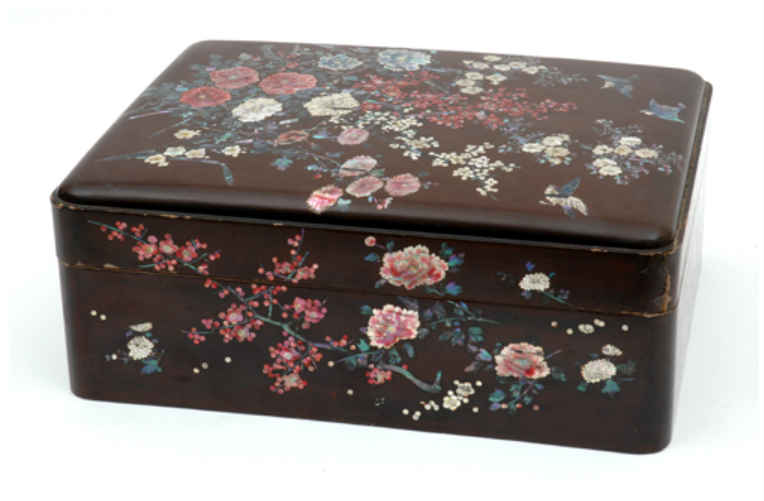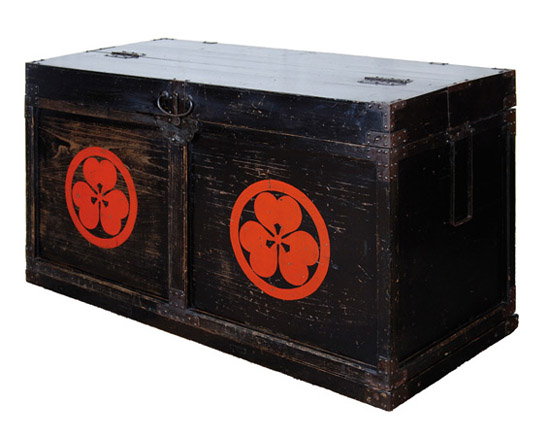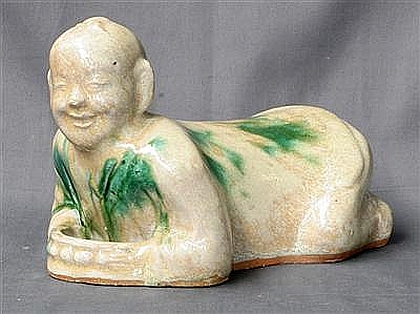Learn about antiques and collectables...
Click on a category below to show all the entries for that category.
Learn about and understand the items, manufacturers, designers and periods as well as the specialist terms used in describing antiques and collectables. Either click one of the letters below to list the items beginning with that letter, or click on a category on the left side of the screen to list the items under that category.
Bi Discs
Bi discs are flat jade discs, with a central opening, and date from pre-historic times. It is believed that the circular form represents heaven, and may have been used in ceremonies honouring the heavens. They were also placed on top of bodies in graves. Early bi discs are undecorated, while disks from later periods have ornate surface carvings.
Celadon
Celadon is the colour of a glaze applied to stoneware and porcelain, that in turn, has given its name to the wares to which it has been applied.
The technique can be traced back to the Shang Dynasty (1600 BC - 1046 BC) in Southern China. The technique spread other areas of China in the 3rd and 4th century, and later to South Korea, Northern Thailand and Japan.
Celadon glazes can be produced in a variety of colors, including white, grey, blue and yellow, depending on the thickness of the applied glaze, the type of clay to which it is applied, and the exact makeup of the glaze.
However, the most famous shades range in color from a very pale green to deep intense green, often meaning to mimic the green shades of jade.
The color is produced by iron oxide in the glaze recipe or clay body.
European potters found it very difficult to attain the sea green colour until the 19th century, following advances in knowledge of chemistry and several factories including Sevres, Copenhagen and Rockwood produced Western versions of the Chinese celadon.
Censer
Censers, also known as incense burners, have a long history in China, dating back to ancient times. They were used for a variety of purposes, including religious ceremonies, medicinal treatments, and as a means of purifying the air.
In ancient China, censers were used in religious rituals and ceremonies, particularly in Taoist and Buddhist temples. They were also used in imperial palaces and government buildings, where they were used to purify the air and to ward off evil spirits. Censers were often made of bronze, and were decorated with intricate designs and motifs, such as dragons, phoenixes, and other symbols of power and authority.
During the Han dynasty (206 BC-220 AD), censers were used in traditional Chinese medicine as a way to burn herbal mixtures to treat illnesses. Censers were also used in the home as part of everyday life, where they were used to purify the air and to create a pleasant aroma.
During the Ming dynasty (1368-1644), the production of censers reached its peak, with many different types of censers being produced, including those made of bronze, ceramic, and porcelain. Censers produced during this time were often highly decorative and were designed to be used as decorative objects as well as functional ones.
In the Qing dynasty (1644-1912), censers were still produced and used, but their popularity and production decreased, as the traditional culture and customs were suppressed by the ruling Manchu dynasty. Today, Chinese censers are still produced and used, but primarily for decorative and cultural purposes.
The Japanese equivalent is known as a koro.
Champleve
An enamelling technique in which the pattern is formed by scooping depressions into the metal surface to be decorated, each of which will contain a single colour, added in powder form and then fired until the enamel melts. When the item has cooled, the surface is polished sothat the enamel is flush with the metal surface. The uncarved sections of the surface remain visible, framing the enamel design.
In technique, champleve differs from cloisonne where the troughs are created by soldering metal strips to the surface of the item.
Charger
A charger is a type of large plate, typically used as a decorative base for smaller plates or bowls. They are often used in formal settings, such as at a banquet or a special occasion.
The history of chargers can be traced back to medieval times, when they were used as a base for serving dishes in banquet settings. They were typically made of metal, such as silver or pewter, and were highly decorative, often featuring intricate engravings or designs.
During the Renaissance period, chargers began to be made of porcelain, and their designs became more ornate. They were often used in the homes of the wealthy and were considered a symbol of wealth and status.
In the 18th and 19th centuries, chargers were produced in great numbers by European porcelain manufacturers, and they were exported to America and other parts of the world. They were highly sought after by the upper class and were often used as a decorative element in formal table settings.
Chatelaine
Originating in the 17th century as a device for suspending seals, by the late 18th century the chatelaine had evolved to become a major item of jewellery, worn from the waist, to which a variety of small implements, cases, and containers could be attached.
It took the form of a metal shield or plate fitted with a hook at the top to attach it to a belt, with a number of hooks at the bottom from which hung a number of short chains.
The objects attached to those chains covered the full gamut of household and personal activities and depending on the station of the wearer, could typically include about 4 to 6 from the following selection: sewing scissors, a scent bottle, keys, a spectacles case, a seal, a sovereign case, a vinaigrette, a vesta case, a pin holder, a snuff bottle, a tape measure, a thimble and a notebook.
Again depending on the station of the wearer , materials used included gold, sterling silver and silverplate.
Nowadays it is common for single items from the chatelaine to come onto the market.
Chinese Cracked Ice Motif
The Chinese cracked ice decorative motif is a traditional design that was commonly used in Chinese art and architecture, particularly in the Ming and Qing dynasties (1368-1912). The motif is characterized by a pattern of small, irregular cracks or fissures that resemble broken ice.
The cracked ice motif was often used in a variety of decorative arts, such as pottery, porcelain, lacquerware, and furniture. It was also used in architectural elements, such as floor tiles, roof tiles, and wall panels. The motif was typically created by carving or incising the surface of the material, and then filling the cracks with a contrasting color, such as black or gold.
The cracked ice motif symbolizes the idea of "coolness" in Chinese culture, and was often used in architectural elements to create a sense of coolness and shade, especially in hot climates. In decorative arts, it is considered as an elegant and refined design that evokes the natural beauty of ice.
Chinese Ding Porcelain
Ding ware is a type of Chinese porcelain that was produced in the northern city of Ding in the Hebei province during the Song Dynasty (960-1279). It is considered to be one of the "Five Great Kilns" of Chinese ceramics, along with Jian, Jun, Guan, and Ru wares.
Ding ware is known for its fine white porcelain body, which was made from kaolin clay, and its elegant shapes and designs. The glaze on Ding ware is usually transparent and has a bluish-white or grayish-white color. It was often decorated with underglaze blue or iron-brown designs.
Ding ware was highly prized during the Song Dynasty, and it was exported throughout Asia and as far as the Middle East and the Mediterranean. It was also an inspiration for other porcelain-making centers in China and Japan. The production of Ding ware declined after the Song Dynasty, and it is now considered to be a rare and valuable collectible.
Circle of .....
In the opinion of the cataloguers, a work of the period of the artist, and closely related in that person's style.
Crackles / Cracquelure
In ceramics, crackles may be introduced intentionally during the firing process, as was often the case with Oriental ceramics, and are known as artificial crackles. Natural crackles occur with age, and if the glaze is transparent, may be difficult to detect. Natural crackles may not cover the whole surface of the object and may be uneven in size.
Famille
The four famille colors used to decorate Chinese porcelain have a long and rich history in Chinese art and culture.
- Famille Verte: This style of porcelain decoration originated during the Kangxi period (1662-1722) and became popular during the late Ming dynasty (1368-1644) and the Qing dynasty (1644-1912). Famille Verte porcelain is characterized by its use of vibrant green, yellow, and black enamels. It was typically used to decorate smaller items such as vases, tea sets, and figurines.
- Famille Rose: Famille Rose porcelain is a more recent development, appearing in the early 18th century. It is characterized by its use of pink, red, and gold enamels. This style was popular among the Chinese elite and was used to decorate larger pieces, such as vases, jars, and other decorative items.
- Famille Jaune: Famille Jaune porcelain is also known as Yellow Ground porcelain and is characterized by its use of yellow enamels. It first appeared in the late 17th century and became popular during the Kangxi period. This style was used to create intricate designs and gilding, and was often used to decorate vases, bowls, and other decorative items.
- Famille Noire: Famille Noire porcelain is characterized by its use of black enamels and is known for its striking contrast between the black enamels and the gold or red highlights in the designs. This style became popular in the late 17th century and was used to decorate a variety of items, including vases, bowls, and figurines.
These four famille colors have been used for hundreds of years to decorate Chinese porcelain and are considered to be some of the most recognizable and well-known styles in Chinese art and culture.
Fitzhugh Pattern
The Fitzhugh pattern on Chinese porcelain refers to a type of decorative design that was inspired by the work of Robert Scott Fitzhugh, an American artist and inventor. However, the Fitzhugh pattern as applied to Chinese export porcelain between c1780 and 1840 often features a distinctively Chinese style, incorporating traditional Chinese elements such as landscapes, figures, and symbols, into the overall design in colours of underglaze blue, bright green, brown and orange. This blend of Western and Chinese decorative elements was a popular style during the late 19th and early 20th centuries, when there was a growing interest in all things Chinese, including porcelain.
Foo Dogs
Foo Dogs, also known as "Fo Dogs", "Fu Dogs", and " Buddhist lions" are the Chinese guardian lions that have traditionally stood in front of Chinese Imperial palaces and tombs, government offices, and the homes of the influential are believed to have powerful mythic protective benefits.
They are a popular motif in decorative arts, especially ceramics and garden statuary, where they are depicted in pairs, comprising of a male resting his paw upon an embroidered ball, representing supremacy over the world, and a female restraining a playful cub, representing the nurturing properties of the female.
Guglet
A guglet is a long necked water bottle designed to keep water cool by evaporation. It received its name from the "gug-gug-gug" sound made when water was poured from it.
Hairwork on Chinese and Japanese Ivory
Hairwork refers to the finely carved details of hair or fur on carved Chinese and Japanese ivory figures carved using a small knife or chisel and required great skill and precision. Hairwork was a popular decorative element on Chinese ivory carvings during the Qing dynasty (1644-1912) and was used to add a sense of realism and texture to the figures.
View further examples of Hairwork on Chinese and Japanese Ivory
Huanghuali Wood
Huanghuali is the most sought-after timber used in the construction of Chinese furniture because of its fine colour and grain.
During Ming and early Qing dynasties, most of the best furniture was made from huanghuali wood.
It is a member of the rosewood family and over time the surface mellows to a yellowish brown tone with the exposure to light.
In recent years, furniture made from huanghuali wood has increased exponentially in value.
Imari and Arita Porcelain
One of the most popular and collected of the Japanese porcelains is Imari. Imari is in fact a European name for export porcelain produced in the town of Arita in the Hizen province of Japan. It was shipped through the nearby port of Imari from the second half of the 17th century and the first half of the 18th century. Pre-export period Imari is called Shoki-Imari.
There are two distinct styles of Arita or Imari porcelain.
Firstly there is the rare and highly sought after Kakiemon porcelain. It is sparsely decorated predominantly in coral red on a very fine white glaze. Highlight colours include yellow, green and aubergine Kakiemon wares are of a consistently high standard and command very high prices
In contrast, the more commonly found Imari in the west is called brocaded Imari or Kinrande Imari, and is usually richly decorated with flowers, foliage and figures. These pieces have an overall floral decoration reminiscent of a rich silk textile, and typical colours are underglaze cobalt blue and iron red, which is highlighted with colours such as gold, green, aubergine and yellow. There is a great variation in quality, ranging from quite crude though decorative wares to very finely painted wares.
Items exported to the West included garnitures of vases, plates, chargers, figures as well as utilitarian wares. Due to its popularity and success, Imari was widely imitated both in China and the West. English factories who produced Imari or "Japan" patterns as they were sometimes known included, Bow, Derby, Minton, Spode, Worcester and Mason's. European factories included Meissen, Chantilly and Delft.
Imperial Yellow
Imperial yellow, also known as "yangqing" in Chinese, is a bright, intense shade of yellow that was historically reserved for the exclusive use of the Chinese imperial family. It was considered the most prestigious and luxurious of all colours, and was used to adorn a wide variety of imperial goods, including porcelain.
Chinese porcelain decorated with imperial yellow was highly prized, and was often used to create exquisite pieces of imperial tableware, such as plates, bowls, and cups. The use of imperial yellow on porcelain was a symbol of the emperor's power and authority and was intended to impress and intimidate visitors to the imperial court.
The process of creating imperial yellow porcelain involved a highly complex and labour-intensive process, which was kept secret by the imperial court. The exact recipe for the yellow glaze used on imperial porcelain is still unknown, although it is thought to have been a combination of lead, tin, and antimony, with the addition of a small amount of iron oxide to achieve the distinctive colour.
Imperial Yellow
Imperial yellow, also called "Chinese Yellow" and "Royal Yellow" is an auspicious colour in Chinese culture.
It was the colour of Imperial China and the symbolic colour of of the five legendary emperors of ancient China. The colour was used to decorate royal palaces and used in the clothing of the emperors.
Inro
Originating in the fifteenth century, an inro was originally a Japanese seal case, used to carry the owner's seal for signature of documents and pigment. Later the inro was modified by adding compartments and was used to carry aromatic herbs, tobacco or medicine. It was suspended from the sash around the owners waist (obi), by a cord secured by a toggle (netsuke). Wood covered in lacquer was the favourite material, though carved wood, ivory, porcelain and pottery, and bamboo were also used. For specialised use iron was employed. The finest examples come from the sixteenth to eighteenth centuries and were decorated with gold or silver in delicate complex patterns, the favourite motifs being birds, beasts, gods, flowers, blossoms, dragons, and clouds, often depicted in an asymmetrical manner, often whimsical, often near abstract. To collectors, the variety of the lacquer is of great interest, whether it is flat, raised, incised or carved.
Iridescent Decoration of Porcelain
Iridescent decoration of porcelain is a technique in which a thin layer of metallic glaze is applied to the surface of porcelain to create a shimmering, rainbow-like effect. The metallic glaze is usually made with a mixture of metal oxides, such as gold, silver, or platinum, that are fused to the surface of the porcelain during firing.
This technique was first developed in the late 19th century, and was particularly popular in Art Nouveau and Art Deco styles of decorative art. Iridescent decoration of porcelain can create a wide range of colours and patterns, depending on the types of metal oxides used and the firing techniques employed. It is a highly skilled and labour-intensive process, requiring a great deal of technical expertise and attention to detail. Today, iridescent porcelain remains a popular and highly valued form of decorative art.
Japanese Obi
The obi is a sash worn with traditional Japanese clothing such as kimono or yukata. The obi is usually wide, ranging from 10-30 centimeters in width, and can be several meters in length, depending on the style and the wearer's size. The obi is tied around the waist, with the ends wrapped around the body and tied in a knot at the back or the front, depending on the occasion and the formality of the attire.
The obi is an essential component of traditional Japanese clothing and is often made from luxurious fabrics such as silk, brocade, or embroidered cloth. It is available in a wide range of colors and designs, from simple and understated to vibrant and ornate, with patterns and motifs ranging from traditional Japanese symbols to modern designs.
The style and design of the obi can convey various meanings and indicate the wearer's social status, age, and gender. For example, a simple and understated obi may be worn for everyday wear, while a more ornate and elaborate obi may be worn for formal occasions such as weddings or tea ceremonies.
Jiajing Mark
The Jiajing mark on Chinese porcelain refers to the reign mark of the Jiajing Emperor (r. 1521-1567) of the Ming Dynasty in China. The mark usually appears as six characters in underglaze blue on the base of the porcelain object and indicates that the object was made during the Jiajing period of the Ming Dynasty.
The Jiajing reign was a time of great artistic production and experimentation in China, particularly in the field of porcelain. The Jiajing Emperor was a patron of the arts and his reign saw the development of new decorative techniques and styles, including the use of underglaze blue decoration, which became a hallmark of Ming Dynasty porcelain.
It should be noted that not all porcelain objects with a Jiajing mark are necessarily from the Jiajing period, as the mark has been copied and imitated by later generations of potters.
Ju Wood
Ju wood, also known as southern elm, is a large-grained wood of which most provincial furniture is made. Its appeal is greatly enhanced by cleaning and waxing.
Kakiemon Porcelain
Kakiemon porcelain was made from the 16th to the 19th century in the Arita area of Japan, and is generally agreed to include some of the finest porcelain made in Japan. It is decorated with polychrome enamels over glaze, the most popular colours being underglaze blue and enamels of green, blue, turquoise yellow and persimmon red.
The body of a Kakiemon object is pure white porcelain while the enamel overglaze motifs incorporate Japanese and Chinese designs, but leave much of the white surface unpainted. The name derives from the family of potters who are associated with this style of pottery.
Early Kakiemon porcelain was unmarked, and marks on later objects were variable and unreliable.
Kakiemon porcelain was first imported into Europe by the Dutch at the end of the 17th century, and became extremely popular, resulting in Kakiemon-style imitations being produced by European potteries including Bow, Chelsea and Worcester in England, Mennery, Samson and St. Cloud in France, Delft in Holland and Meissen in Germany.
It's rare for an original Kakiemon object to come onto the market, and almost all sold nowadays is of European origin, and described as Kakiemon pattern or Kakiemon style.
Kutani Ware
It is believed that Kutani ware was first manufactured in what was the Kaga Province of Japan in the seventeenth century, supposedly inspired by the techniques used at Arita.
However production of Kutani ware ceased towards the end of the 17th century, and it was not until the 19th century that production was revived.
The objects produced during the short period of about 60 years that the kilns were in production in the 17th century are called ko Kutani, but objects from this period rarely appear on the market. The items sold as Kutani, also known as Kaga-style wares, are from the 19th century.
The colours used included a brownish red, muddy yellow and intense green, on a greyish ground.
Many different porcelain products were made, mostly for the Western market, including tea and coffee sets, dishes, bowls, incense burners and small decorative items.
Kylin or Qilin
A kylin or qilin is a mythical Chinese animal, dating back to the 5th century with the head of a dragon, the body of a deer and the tail of a lion. It is a regarded as a good omen bringing serenity and prosperity, and is said to appear with the coming or departure of a wise sage or illustrious ruler.
It is also part of the culture of Korea and Japan.
As well as being represented in bronze and jade, it is also used as a decorative motif on ceramics.
Lacquered Lacquerware
Lacquer is a clear or coloured resin that is obtained from the sap of several species of trees in the genus Rhus, particularly the Rhus verniciflua tree, which is native to China and Japan. The resin is harvested by making incisions in the tree bark and collecting the sap that oozes out.
The sap is then processed and refined through a series of steps, which may include filtration, heating, and chemical treatments. The resulting lacquer is a highly durable and glossy material that is used as a finish for furniture, musical instruments, and other objects.
Lacquer has been used for thousands of years in Asia, where it is valued for its beauty and durability. It is applied in multiple thin layers, with each layer being allowed to dry and harden before the next one is added. The process can take several weeks or even months to complete, but the resulting finish is incredibly hard, glossy, and resistant to scratches and wear.
The lacquer derived from the resin of the Rhus tree has been used for decoration of furniture in several countries in Asia, particularly China, Japan, Korea, and Vietnam. These countries have rich traditions of using lacquer for furniture decoration and have developed unique techniques and styles of lacquer work.
In China, lacquer has been used for furniture decoration for over 2,000 years, and it became a major art form during the Ming (1368-1644) and Qing (1644-1912) dynasties. Chinese lacquerware is known for its intricate carving, painting, and inlay work, as well as its use of bold colours and designs. Lacquer was used to decorate furniture such as cabinets, screens, and chairs.
In Japan, lacquer has been used for furniture decoration for over 1,000 years. Japanese lacquerware is characterized by its simplicity and elegance, and it often incorporates natural materials such as wood, bamboo, and shells. Lacquer was used to decorate furniture such as chests, cabinets, and trays.
In Korea, lacquer has been used for furniture decoration for over a thousand years. Korean lacquerware is known for its restrained and understated beauty, and it often features delicate patterns and designs that are achieved through careful layering and carving. Lacquer was used to decorate furniture such as cabinets, chests, and screens.
In Vietnam, lacquer has been used for furniture decoration for over 2,000 years. Vietnamese lacquerware is known for its vibrant colours and intricate designs, and it often features scenes from daily life, nature, and mythology
Lappet Decoration
In the context of furniture, ceramics, and oriental wares, the word "lappet" refers to a decorative motif that consists of a repeated pattern of stylized or abstracted "lappets."
A lappet in this context is a decorative element that resembles a small, hanging flap of cloth or fabric, but rather are stylized patterns that resemble the shapes and folds of lappets. They can be found on a wide range of objects, including furniture, vases, bowls, and plates.
Lappet decoration can take many different forms, but typically consists of a series of semi-circular or pointed shapes that are repeated in a continuous pattern. The shapes may be simple or highly ornate and may be arranged in a regular or irregular pattern. The design may also include other decorative elements, such as floral or foliate motifs.
Lappet decoration is often associated with Asian design traditions, and can be found on a wide range of objects from these regions, including Chinese porcelain, where lappet decoration is often used as a symbol of abundance and prosperity, and is believed to have protective and auspicious qualities.
Ming Dynasty
The Ming Dynasty was a ruling dynasty of China from 1368 to 1644. It succeeded the Yuan Dynasty and preceded the Qing Dynasty. The Ming Dynasty was established by Zhu Yuanzhang, a former Buddhist monk who became a rebel leader and eventually overthrew the Mongol Yuan Dynasty. During the Ming Dynasty, China experienced a period of relative stability and prosperity. The government was centralized and bureaucratic, with the emperor at the top of the hierarchy. The Ming Dynasty is known for its cultural achievements, including the development of porcelain, the invention of movable type printing, and the construction of the Great Wall of China.
Mon
A mon is a Japanese heraldic emblem, indicating the status or the family of the owner, similar to a family crest. Nowadays almost all Japanese families and many businesses have a mon.
In decorative arts, mon are used as a decorative element on a vase, plate, bowl or item of furniture.
Nagamochi
A Japanese chest, usually on castors used for storing clothing or bed linen.
Nanking Cargo
The Nanking Cargo was named after the type of porcelain in the Dutch East India Company ship "Geldermalsen", which sank near Java in 1751 and was salvaged in 1985.
The cargo was salvaged by a team led by Captain Mike Hatcher and included over 150,000 pieces of blue and white porcelain, 125 rrare Chinese gold ingots and two important cannons.
The cargo was sold by Christie's in Amsterdam, comprising 2,800 lots spread over 5 days in April - May 1986, realising over $US20 million.
Netsuke
As the kimono, the traditional form of Japanese dress, had no pockets, the Japanese men suspended small items they needed to take with them, such as tobacco pouches, purses, pipes and writing implements on a silk cord from their sash, and stop the cord slipping, it was fed through a toggle - a netsuke.
Originally the toggle was made from found objects such as roots or shells, which were selected for their aesthetic appeal, but over time the toggle itself developed as an art form. Many fine carvers devoted themselves to netsuke, but the demand was so great, that their manufacture was taken up by other craft persons such as lacquerers, metal artists and potters.
While ivory is the most commonly used material, netsuke were also made from wood, bone, lacquer, metal and other materials.
The custom of wearing netsuke flourished in Japan for more than three centuries - from around 1600 to the mid 19th century, but the golden age of the netsuke is considered to be from 1800 to 1850. The custom developed in the 16th century when tobacco smoking using a pipe was introduced by the Portuguese. This required the smoker to carry his smoking accoutrements and were a major factor in the wide use adaption of the netsuke.
Innumerable designs were produced, with ivory the most-used material, but also in wood, stone, amber, lacquer
During this period, Japan was a closed society with no foreign trade or influence, but this was changed by the visits of Commodore Matthew Perry in the 1850s. With the opening up of Japan to the west, smoking preferences changed from the pipe to the cigarette, and dress habits changed from traditional Japanese garments to western dress, leading the decline in use of the netsuke.
The western world discovered the artistry of the netsuke in the late 19th century and many great collections are formed. As awareness of the netsuke increased, the demand from tourists developed, and to satisfy the market, many netsuke style items were mass produced. They were produced in all types of materials including plastic. If produced by a mould often the mould marks can be seen. More elaborate copies may be hand carved, and with a fake copy of the signature an original master netsuke maker.
Factors that contribute to the value of a netsuke are authenticity, the skill of the artisan, the condition, and if signed, the name of the artist. The most difficult of these to determine is authenticity, as ageing can be faked, and it takes a long period of study of the netsuke to become competent in this area.
Overglaze on Porcelain
Overglaze decoration on porcelain refers to a decorative technique where designs are painted onto a fired and glazed porcelain surface, and then fired again at a lower temperature to fuse the decorative design onto the glaze surface. This technique allows for a wide range of colors and intricate designs that would not be possible with underglaze decoration, which is applied before the glaze is fired.
Overlay Glass
Overlay glass is coloured glass that has been created by sandwiching two or more layers of different coloured glass together. The layers are fused together through a process of heating and melting in a glass furnace, and the resulting glass has a unique colour and depth that is not found in single-layered glasses.
The technique of overlaying glass has been used for centuries, and was particularly popular in the Venetian glass industry during the Renaissance. Different colours of glass were layered to create intricate designs, and then the layers were carved and etched to create intricate patterns and details.
Peach Bloom
Peach bloom glaze is a type of ceramic glaze that was commonly used in Chinese pottery during the 18th and 19th centuries. It is a type of monochrome glaze that ranges in colour from pale pink to deep red, resembling the colour of a peach blossom.
The glaze is created using a combination of iron oxide and copper oxide, which are mixed together in specific proportions and applied to the ceramic surface. The glaze is then fired in a kiln at a high temperature, which causes the iron and copper oxides to interact and create the characteristic range of colours.
Peach bloom glaze is known for its delicate, translucent quality, which allows the underlying ceramic body to show through in places. It was used to decorate a range of ceramics, from small vases to large bowls and plates. The technique was particularly popular during the Qing Dynasty.
Pillows - Oriental
When looking at the images on this page, you may think there is a mistake with the heading "pillows", but illustrated below are hard Chinese and Japanese pillows, the complete opposite of what we expect in a pillow today.
This style of pillow was in use from about the 6th century to the end of the 19th century, although the pillows on this page are from the later period. They were designed to keep the neck and head in vertical alignment with the spine, as with present day pillows, but without the head comfort of the soft pillows we use today.
The most common shape was a brick with an inverted top, but other whimsical shapes included a recumbent child lying on his stomachs, where the curved back was the head rest, cats crouching also using the back as the head rest, and mythical animals.
Most pillows are porcelain; less common are wood, hardstone, lacquer, and jade.
Powder-Blue
Powder-blue, also known as "Jingdezhen blue" or "suffuse blue," is a captivating decorative technique used in Chinese ceramics from the 15th to the 19th centuries. Its name aptly reflects the application method, where finely ground cobalt oxide is dusted onto the ceramic surface, creating a soft, ethereal blue hue. The uneven dusting results in soft gradations of blue, with darker spots around contours and lighter areas on flat surfaces. The blue often appears translucent, allowing the underlying clay colour to subtly influence the final shade.
Powder-blue was primarily used on porcelain, particularly in high-end pieces produced in Jingdezhen, the famed porcelain capital of China, but its popularity declined in the latter part of the 19th century.
Republic Period
The Chinese Republic period, also known as the Republic of China period, lasted from 1912 to 1949. It began with the overthrow of the Qing Dynasty in 1911 and the establishment of the Republic of China under Sun Yat-sen. During this period, the country underwent significant political, social, and economic changes, including the adoption of a new constitution, the expansion of civil liberties, and the modernization of the economy. However, the Republic of China period was also marked by political instability, with numerous warlords and factions vying for power and influence, and the country was eventually engulfed in a civil war between the Nationalists and the Communists. The Republic of China period came to an end in 1949, when the Communists emerged victorious and established the People's Republic of China, while the Nationalists retreated to Taiwan where they established a separate government.
Rouleau Vase
A Chinese porcelain vase shape with straight cylindrical shape and a straight narrow neck raising from an angular shoulder. [Gotheborg.com]
Sang-De-Boeuf
Flambe glazes, termed "sang-de-boeuf" (ox blood) were in use by the Chinese from the 11th century, and the effect was achieved by using copper oxide as a colouring agent and firing the object in a reducing atmosphere.
In the 18th century the red glaze often accumulated on the shoulders of vases and bowls, reproducing the effect of coagulated blood. Sometimes the glaze was often slightly streaked, or included blue bleeds and wares with these features were prized by collectors in the 19th century.
European potters were not able to master the technique until the early 20th century. The Royal Doulton company employed the potter Bernard Moore, who had been experimenting with flambe glazes for many years, as a consultant and they were able to produce their first flambe wares in 1904.
Soapstone
Soapstone is a soft rock, that has been carved by the Chinese for centuries, and is still being carved today. The name derives from the soap-like feel that some of the softer grades of soapstone have.
The softness of the rock is due to talc in its composition, and the amount of talc can vary from 80% (very soft) to about 30%. On the Mohs scale of hardness, soapstone has a hardness of 1 to 5, whereas jade has a hardness of 6 to 6.5. It is often possible to scratch a piece of soapstone with a fingernail or knife blade.
Because of continuing production over several centuries, it can be difficult to date soapstone carvings, and there are many that were made for the tourist market.
Soapstone carvings are generally not expensive and the quality of the carving and the size and colouring of the soapstone contribute to the determination of value.
Colours of soapstone can vary and include off-white, red, green and brown.
Song Dynasty
The Song Dynasty was a ruling dynasty in China from 960 to 1279 AD. It was divided into two periods, the Northern Song (960–1127) and the Southern Song (1127–1279). The emperor was the ultimate authority, but he relied on officials who were selected based on their merit and skills rather than their family background or social status. The Song Dynasty was a period of great artistic and cultural achievements, particularly in the areas of poetry, painting, and calligraphy. The Chinese invented the printing press during this period, which revolutionized the spread of knowledge and ideas. During the Song Dynasty, China had a prosperous economy and was a centre of international trade, particularly in luxury goods such as silk, tea, and porcelain. The use of paper money became more widespread during this period, facilitating commerce and trade.
Tea Caddy
In the 17th century, tea was first introduced to Britain from the East Indies by the Dutch East India Company who had a monopoly on this trade, as well as some of the spices now in common use. As a result, the leaf tea from which the drink was made was an extremely expensive commodity, and so had to be appropriately stored and safeguarded. The tea caddy was devised for this purpose.
The first tea caddies, sometimes called tea canisters, as they were only single compartment vessels, were often of silver, and bottle shaped with a removable top that could be used to measure tea into the pot.
In the 18th century, taxes were imposed on tea making it even more expensive, and to safeguard the contents a lockable box was devised. The simple forms of these boxes had a removable receptacle to store the tea. The larger examples housed two receptacles side by side. The tea containers were often lined with a silver paper like substance presumably to protect the tea from moisture. The tea receptacles were often separated by a glass bowl, usually referred to in auction catalogues as the "mixing bowl" or "blending bowl", the idea being that each of the two containers held a different variety of tea, and they were blended in the bowl in proportions suitable to the maker, before being added to the teapot. Others, however, believe the bowl was used for sugar.
The most common material used for tea caddies in the 18th century was silver, and in the 19th century was wood, but tea caddies are also commonly seen finished in pewter, ivory, tortoise-shell, mother-of-pearl, brass, copper, papier mache and silver.
Befitting their status, the finest materials and craftmanship were used in the manufacture of tea caddies, emphasised by the complicated shapes which were variations on a square, rectangle or casket.
In 1784 the tax on tea was reduced from over 100% to 12.5%, and at the same time the monpoly on supply of tea by the Dutch East india Company was beginning to wane. As tea grew cheaper, there was less concern with safeguarding the contents, and as a result the of the tea caddy slowly declined. Most tea caddies avaiolable on the market were made before the mid 19th century.
A variation on the tea caddy is the teapoy, where a larger version of the tea caddy was mounted on a stem and base to form a small table.
Vung Tau Cargo
The Vung Tau wreck, named after the port near which it was discovered, was found by fishermen off the islands of Con Dao in the south of Vietnam, when they retrieved porcelain items that had caught in their nets.
Master mariner, Sverker Hallstrom who had good relations with the Vietnamese government, obtained the license to excavate the wreck after the Vietnam Salvage Corporation had carried out preliminary excavation, and Australian Michael Flecker directed the primary excavation for Hallstrom in 1991.
Experts surmised that the ship was bound from China to Batavia (now Jakarta) circa 1690, where the bulk of the ceramics would have been trans-shipped to a Dutch East India Company vessel for the onward voyage to Holland.
The salvage operation recovered over 48,000 ceramics items, mostly Kangxi blue-and-white porcelain, an impressive collection of white-ware, many pieces of provincial ware, and a wide variety of ship related artefacts.
Christie's auction house selected 28,000 pieces of porcelain for auction in Amsterdam, and the sale raised $US 7.3 million. A full representation of the ceramics and most of the artefacts were put on display in the Vung Tau Museum, whilst the remainder of the ceramics, mostly damaged to some extent, were divided between Hallstrom and the Vietnamese Government.
Zitan Wood
Zitan is the most expensive, and since ancient times, has been considered the most precious of woods.
Zitan wood is the hardest and heaviest of all hardwoods. It is purplish-black to black in colour, and with a grain so dense it is virtually invisible.
Zitan can usually only be obtained in quite narrow strips and so it is rare to find large pieces of furniture made from this wood. True Chinese rosewood is a variety of zitan and is very rare.
